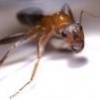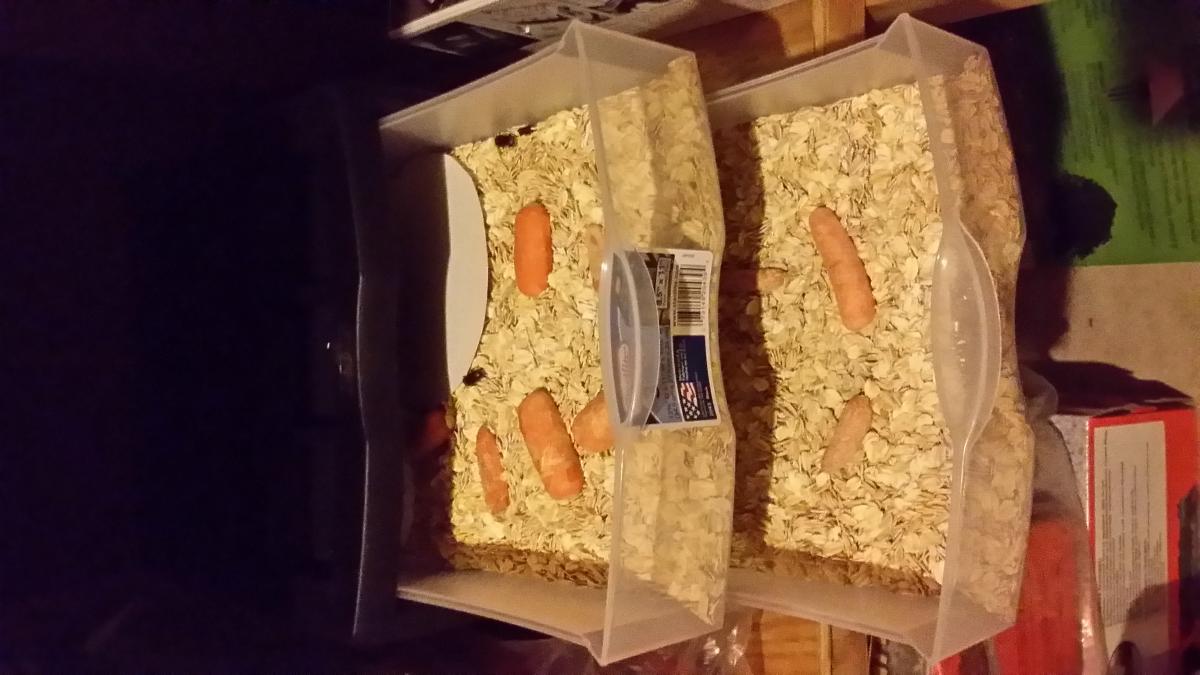- Formiculture.com
- Forums
- Gallery
- Members
- Member Map
- Chat

Feeding Routine?
Started By
Works4TheGood
, Oct 18 2015 9:41 PM
15 replies to this topic
#1
 Offline
-
Posted October 18 2015 - 9:41 PM
Offline
-
Posted October 18 2015 - 9:41 PM
I've been wondering about this for a while now: how often should I be replacing my colony's food supply? With such small colonies like mine, it's sometimes difficult to know which food items are getting eaten and which aren't, and my question is when should I be removing any uneaten food? For example, I froze some ants and larvae for my S. molesta. And then put them in the outworld, but I think my ants turned up their noses. How long do you folks generally leave food items like this lying around?
Also, mostly as an experiment, I threw in some scrambled egg (with cheese), and it seemed to harden in 24 hours. I'm not sure if they're doing anything with it or not, so how long should I leave it there?
What about sugary items? Same rules?
Also, mostly as an experiment, I threw in some scrambled egg (with cheese), and it seemed to harden in 24 hours. I'm not sure if they're doing anything with it or not, so how long should I leave it there?
What about sugary items? Same rules?
~Dan
#2
 Offline
-
Posted October 19 2015 - 6:04 AM
Offline
-
Posted October 19 2015 - 6:04 AM
I just leave the food in mine until the next time I have a chance to clean it out. Some of my colonies' out worlds are a pain in the butt to open, so I leave stuff in there longer. I don't think it matters too much unless it starts to mold.
- Gregory2455 likes this
#3
 Offline
-
Posted October 19 2015 - 6:16 AM
Offline
-
Posted October 19 2015 - 6:16 AM
If it is in an outworld, I try to remove it after a day or so if no ants have touched it. If they are still working on it, I will leave it until it dries out (I rarely get mold in my location due to low humidity, especially in foraging areas).
In a test tube I am more prompt about removing it, due to chances of mold.
"Always do right. This will gratify some people, and astound the rest." -- Samuel Clemens
#4
 Offline
-
Posted October 19 2015 - 4:37 PM
Offline
-
Posted October 19 2015 - 4:37 PM
... I will leave it until it dries out ...
So if the food goes dry, they won't eat it? If I were to wet it with some water, is it good to go for a while?
~Dan
#5
 Offline
-
Posted October 19 2015 - 5:29 PM
Offline
-
Posted October 19 2015 - 5:29 PM
I check food items every 24 hours because I don't want mold. I remove old squishy food because it means its going to mold. I feed my P. Rugosus, P. Californicus and novomessors freeze dried meal worms, crickets and grasshoppers. I also give them blue grass seed. rarely honey or sugar water.
Current Colonies;
Acromyrmex Versicolor
Dorymyrmex Bicolor
Pogonomyrmex Californicus
Pogonomyrmex Rugosus
Pogonomyrmex Tenuispinus
Novomessor Cockerelli
Myrmecocystus Mexicanus
Last Update: 08 Jul 2016
#6
 Offline
-
Posted October 20 2015 - 10:59 AM
Offline
-
Posted October 20 2015 - 10:59 AM
... I will leave it until it dries out ...
So if the food goes dry, they won't eat it? If I were to wet it with some water, is it good to go for a while?
In my climate, food generally dries out instead of molding. In more humid locations, mold is a more pressing concern.
My ant species have zero interest in dry food. Wetting them with water doesn't exaclty help, unless it is with Terry's gel formulas.
Why bother going to all the work of trying to cut corners by just re-wetting it, when I can just remove it and add another half of a mealworm? I have a huge culture of mealworms, a few less mealworms isn't going to bother me. ![]()
"Always do right. This will gratify some people, and astound the rest." -- Samuel Clemens
#7
 Offline
-
Posted October 20 2015 - 2:07 PM
Offline
-
Posted October 20 2015 - 2:07 PM
Anyone have a micro-vacuum to recommend?
PTAntFan----------------------------------Pogonomyrmex Californicus*****************************<p>I use the $3 Tower I made up. See it here.
#8
 Offline
-
Posted October 20 2015 - 7:48 PM
Offline
-
Posted October 20 2015 - 7:48 PM
I use a dust buster with a homemade aspirator attached. ![]()
I can fish out any workers sucked up afterwards and I don't lack for suction.
There are quite a few mini vacuums out there on ebay/amazon, but I do notice that most have car plugins so you would need an adaptor for those.
"Always do right. This will gratify some people, and astound the rest." -- Samuel Clemens
#9
 Offline
-
Posted October 20 2015 - 9:21 PM
Offline
-
Posted October 20 2015 - 9:21 PM
I also have a small colony with about 13 workers, so they don't normally eat all of the food I put out. I alternate between Formula Blue and Sunburst nectar+whey protein. In terms of feeding routines, I typically change out my food daily (once it dries out). So I do waste quite a bit, but I just want to make sure that calories and protein are not the limiting factor in their growth. Though sometimes I'll stretch a Formula Blue cube out an extra day adding a drop or two of Sunburst nectar to keep it moist. I don't know if that voids my warranty on the Formula Blue ![]()
#10
 Offline
-
Posted October 20 2015 - 9:54 PM
Offline
-
Posted October 20 2015 - 9:54 PM
When the food has dried up, I just use some stick (pin, extended paper clip, etc) and dip the tip with some water. Then use it to adhere the dried up foods. This method also works well in moving broods, taking off sands or stealing off broods and groups of eggs from the wild colony (more efficient if larger branch, but be gentle).
#11
 Offline
-
Posted October 22 2015 - 9:47 AM
Offline
-
Posted October 22 2015 - 9:47 AM
... I have a huge culture of mealworms, a few less mealworms isn't going to bother me.
I've been trying that. However, my beetles never produce any sign of offspring. No clue why. I've had the beetles for months now.
~Dan
#12
 Offline
-
Posted October 22 2015 - 11:20 AM
Offline
-
Posted October 22 2015 - 11:20 AM
About 2 months ago I moved my mealworms to a bin with fresh bedding and had 2 cups full of squirming worms. This is despite feeding about 30 colonies, most of which are over the 20 worker mark, with a couple being over the 100 worker mark.
Here is my setup:
Large plastic shoe box (24" x 14" x 10")
5-6" of bran bedding (more than 50% oats can cause humidity issues, I have had much better success after going 100% bran bedding)
Egg carton pieces or crumpled up paper towel in one corner
The beetles hang out in the carton or in the paper towel, and usually only venture out to lay eggs or to explore a bit. This helps keep the eggs from being eaten. Beetles love to eat the eggs and young larvae, which is why it is good to have a large container and several inches of bedding. I never move my pupae or beetles unless I am starting a second culture, with all that bedding, most of the pupae survive to eclosing with no issues.
It does take two months or so to actually see the small mealworm. It is growing from an extremely small egg. I usually see a flake or two of bran moving and only when I investigate do I realize it is actually a tiny mealworm that is smaller than most of my ants.
"Always do right. This will gratify some people, and astound the rest." -- Samuel Clemens
#13
 Offline
-
Posted October 22 2015 - 6:08 PM
Offline
-
Posted October 22 2015 - 6:08 PM
I had a lot of problems early on with many of the pupae dying or not enclosing or emerging properly. I still am baffled why, but perhaps that's symptomatic of a bigger problem. I have an inch of oats, and I feed them carrots for moisture. What about you?
I didn't know that they were cannibals, but I don't think that that's my primary problem, although it probably contributes.
I didn't know that they were cannibals, but I don't think that that's my primary problem, although it probably contributes.
Edited by Works4TheGood, October 22 2015 - 6:16 PM.
~Dan
#14
 Offline
-
Posted October 22 2015 - 7:28 PM
Offline
-
Posted October 22 2015 - 7:28 PM
Just oats?
Several people have noticed that if you have over 50% oats, you are very likely to have eclosing problems and pupae deaths.
Try switching to 100% bran. Lot fewer problems.
I use 100% bran, throw in an occasional apple core or carrot peel. If I don't feed veggies, then I mist lightly once every 2 weeks.
"Always do right. This will gratify some people, and astound the rest." -- Samuel Clemens
#15
 Offline
-
Posted November 27 2015 - 7:10 PM
Offline
-
Posted November 27 2015 - 7:10 PM
Hey Crystals, you were right! I hadn't waited long enough. Now there are lots of mealworms. I looked for bran at Weis, Walmart, and Tractor Supply, but to no avail. I might have to order it at Amazon. I'm guessing that they just need more humidity, which I might be able to fix without switching. We'll see.
~Dan
#16
 Offline
-
Posted December 6 2015 - 10:21 PM
Offline
-
Posted December 6 2015 - 10:21 PM
... I will leave it until it dries out ...
So if the food goes dry, they won't eat it? If I were to wet it with some water, is it good to go for a while?
I keep food in there until the next time I feed my colonies. It basically dries up in a day or so, but it is fine for it to stay until the next feeding. I often see Pogonomyrmex and other species chewing on the dry food anyway. Do not wet food because it will mold.
1 user(s) are reading this topic
0 members, 1 guests, 0 anonymous users





















